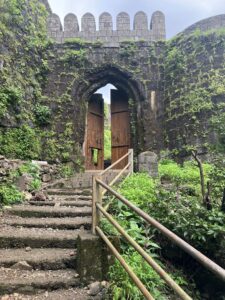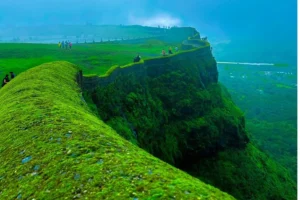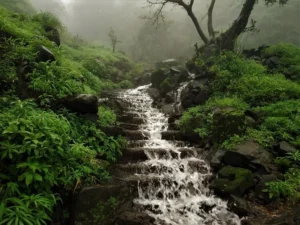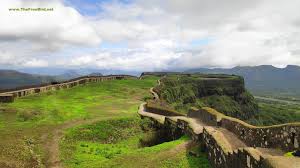Korigad Fort

Introduction
Nestled in the lush green hills of Maharashtra’s Pune district, Korigad Fort is a magnificent historical structure that stands as a testament to the region’s rich heritage. Located near Lonavala, this fort offers a breathtaking trekking experience combined with historical significance and scenic beauty.
The fort, perched at an altitude of about 923 meters (3,028 feet) above sea level, is known for its well-preserved ramparts, temples, and mesmerizing views of the surrounding Aamby Valley. If you are an adventure enthusiast, history buff, or nature lover, a visit to Korigad Fort is a must.
In this comprehensive guide, we will explore the history, trekking route, attractions, and essential travel tips to make your trip to Korigad Fort a memorable one.
Historical Significance of Korigad Fort
Korigad Fort, standing proudly amidst the Sahyadri ranges, is steeped in history and has witnessed several significant events that shaped Maharashtra’s past. Built around the 15th century, the fort played a crucial role in the military strategies of various rulers over the centuries. It was a stronghold of the Marathas and later became a point of contention during the British conquest of India.
Korigad and Chhatrapati Shivaji Maharaj
Korigad Fort became a part of Chhatrapati Shivaji Maharaj’s empire in 1657, when he captured it along with several other forts in the region, such as Lohagad, Visapur, Tung, and Tikona. These forts were strategically chosen to form a defensive chain around Pune and were instrumental in establishing Shivaji Maharaj’s rule in the western parts of India.
The fort was primarily used to store arms, ammunition, and food supplies, making it an essential military outpost. It also provided a vantage point to keep a watch on enemy movements in the nearby valleys and trade routes. Given its elevated position and robust walls, Korigad served as a formidable defense structure, allowing Maratha warriors to hold their ground against rival forces.
The Role of Korigad in the Anglo-Maratha War

The Anglo-Maratha War of 1817-1818 marked the decline of the Maratha Empire and the rise of British control over India. Korigad Fort was one of the last forts to fall into British hands.
- In March 1818, the British forces led by Colonel Prother decided to seize Korigad as part of their campaign to take over the forts in Maharashtra.
- The British used heavy artillery and cannons to attack the fort, but due to its strong stone walls, the fort withstood the initial bombardment.
- Despite the resistance from the Maratha soldiers stationed at Korigad, the British finally managed to breach the fort after several days of battle.
- One of the key events during this battle was the firing of cannons from a nearby hill, which created a breach in the fort’s walls, forcing the defenders to surrender.
Following its capture, the British destroyed parts of the fort to ensure it could not be used as a military base again. However, even after years of neglect, the fort remains structurally intact, with its walls, gateways, temples, and water reservoirs still standing.
Korigad’s Strategic Importance
Korigad Fort’s location near the trade routes of the Deccan Plateau made it a highly valuable asset for different rulers. It provided a natural stronghold due to its steep cliffs and dense forests, making enemy attacks difficult. Additionally, its proximity to Lonavala and other fortresses allowed for an interconnected defense network among the Maratha strongholds.
The fort’s massive stone walls, bastions, and fortified gates were designed to withstand both direct attacks and prolonged sieges. Even today, the fort remains an architectural marvel, showcasing the engineering brilliance of ancient Indian fortifications.
Korigad Fort in Modern Times
Today, Korigad Fort stands as a testament to Maharashtra’s rich history and military prowess. While much of its glory has faded over time, its ruins continue to narrate stories of valiant battles, strategic defense, and the resilience of its defenders.
Visitors can explore the remnants of its two large gates, temple structures, cannon placements, and water cisterns, which provide a glimpse into the life of the soldiers who once guarded its walls. The fort’s elevated position offers breathtaking views, allowing visitors to experience the grandeur that once made it an impregnable fortress.
With its historical significance, stunning landscape, and easy accessibility, Korigad Fort remains one of the best-preserved hill forts in Maharashtra, attracting history enthusiasts, trekkers, and adventure seekers alike.
How to Reach Korigad Fort
By Road:
- The fort is located about 20 km from Lonavala and can be easily accessed via Mumbai-Pune Expressway.
- You can take a private vehicle or hire a cab from Lonavala to the base village, Peth Shahpur.
By Train:
- The nearest railway station is Lonavala Railway Station, which is well-connected to Mumbai and Pune.
- From Lonavala, you can take a local taxi or bus to reach Peth Shahpur.
By Air:
- The nearest airport is Pune International Airport, about 90 km away from the fort.
- You can hire a cab from Pune to reach the base village.
Trekking Guide to Korigad Fort

Korigad Fort is a relatively easy trek, making it suitable for beginners as well as experienced trekkers. The trek takes around 60–90 minutes to reach the top, depending on your pace.
Trekking Route:
- Starting Point: The trek begins from Peth Shahpur village.
- Initial Trail: The initial part of the trek involves walking through a forest trail with slight inclines.
- Stone Steps: A flight of around 600 stone steps leads to the fort’s entrance, making the ascent convenient.
- Main Entrance: The fort has two main gates, known as Ganesh Darwaja and Kori Darwaja.
- Summit: Once you reach the top, you are welcomed by panoramic views of the Aamby Valley, Pawna Lake, and Mulshi Dam.
Best Time to Visit:
The best time to trek Korigad Fort is during the monsoon (June to September) and winter (October to February). The post-monsoon season offers lush greenery, misty trails, and pleasant weather, making the experience truly magical.
Attractions at Korigad Fort
1. Fort Walls and Bastions
One of the most striking features of Korigad Fort is its well-preserved fortification. The walls provide a breathtaking view of the surrounding landscape, making it a great spot for photography.
2. Koraidevi Temple
Dedicated to Goddess Koraidevi, this temple is located at the highest point of the fort. Devotees and trekkers often visit this temple to seek blessings before exploring the fort.
3. Cannon Relics
The fort houses several old cannons, a reminder of the battles fought here. The most prominent cannon is near the main entrance, giving you a glimpse of the fort’s military history.
4. Water Tanks and Caves
Several large water tanks at the top of the fort provided drinking water to the soldiers in ancient times. These tanks still hold water, showcasing the brilliant water conservation techniques of that era. There are also a few small caves near the temple that can be explored.
5. Aamby Valley View
One of the biggest attractions of Korigad Fort is its stunning view of Aamby Valley. The sight of the modern city juxtaposed against the historical fort makes for a mesmerizing experience.
Essential Tips for Visiting Korigad Fort

- Wear comfortable trekking shoes as the stone steps can be slippery, especially during monsoon.
- Carry sufficient water and snacks, as there are no eateries at the top.
- Start early in the morning to avoid the afternoon heat and enjoy a peaceful trek.
- Avoid trekking alone and try to visit with a group, especially during the monsoon season.
- Respect the fort’s heritage by not littering and maintaining cleanliness.
- Check the weather forecast before planning your trip, as heavy rains can make the trek challenging.
1. Wear Proper Trekking Gear
- The trek to Korigad Fort involves walking on uneven, rocky terrain and stone steps, which can get slippery, especially during the monsoon.
- Wear good-quality trekking shoes with a firm grip to avoid slipping.
- Avoid wearing sandals or flip-flops as they are unsuitable for trekking and may cause injuries.
- If visiting in the winter, carry a light jacket to stay warm, as the temperature can drop early in the morning.
2. Carry Enough Water and Snacks
- There are no food stalls or water sources at the top of the fort, so it’s important to carry at least 2 liters of water per person.
- Bring energy bars, dry fruits, or snacks to keep yourself energized throughout the trek.
- If you plan to have a meal at the top, pack lightweight food like sandwiches, fruits, or homemade parathas.
- Avoid carrying too much junk food, as it may increase the chances of littering.
3. Start Early in the Morning
- The best time to start your trek is early in the morning (between 6:00 AM – 7:00 AM).
- Morning treks are more pleasant, as the weather is cooler, and you can avoid the scorching heat of the afternoon sun.
- An early start also allows you to complete the trek before it gets crowded, giving you a peaceful and serene experience at the fort.
4. Avoid Trekking Alone
- If you’re an experienced trekker, you may feel confident about trekking alone, but it’s always safer to go with a group or at least one companion.
- The route is not well-marked in some places, and first-time trekkers might get confused.
- Trekking with a group ensures better safety in case of emergencies.
5. Be Cautious During Monsoon Season
- Korigad Fort is stunning during the monsoon season (June-September), with lush greenery, misty trails, and small waterfalls. However, the rain can make the stone steps and trails extremely slippery.
- Wear water-resistant shoes and carry a light raincoat or poncho instead of an umbrella, as the winds can be strong.
- Be extra cautious near steep edges and cliffs, as the wet surface increases the risk of slipping.
- If you’re planning to visit during heavy rainfall, check the weather forecast beforehand to avoid landslides or thunderstorms.
6. Respect the Fort and Environment
- Do not litter—carry a small bag to collect your waste and bring it back down.
- Avoid damaging historical structures or writing on the fort’s walls.
- Do not pluck flowers, disturb wildlife, or make unnecessary noise, as the fort is a natural habitat for birds and animals.
- Maintain silence and appreciate the serene beauty and historical importance of the place.
7. Pack Smart and Travel Light
- Carry only the essentials, such as water, snacks, a camera, a raincoat (if visiting during monsoon), and a small first aid kit.
- Avoid overloading your backpack with unnecessary items, as a heavy bag can slow you down and make the trek exhausting.
8. Travel with Proper Permits (if required)

- Korigad Fort does not require an entry fee, but it is always advisable to check with local authorities for any recent changes.
- If you’re visiting in a large group, inform the local forest department in advance.
- Some trekking groups organize guided treks to Korigad, which can be helpful for first-time visitors.
9. Carry Basic First Aid and Medicines
- Carry band-aids, antiseptic cream, pain relievers, and insect repellent in case of minor injuries.
- If you have any existing medical conditions, keep your prescribed medicines with you.
- Trekking can sometimes cause dehydration, so carrying ORS (oral rehydration salts) or glucose powder is a good idea.
10. Plan Your Transport in Advance
- If you’re traveling by car, check for parking spaces near the base village, as parking might be limited on weekends.
- If using public transport, confirm the timing of buses or trains beforehand, as options might be limited in the evening.
- Hiring a local guide or asking locals for directions can be helpful if you’re unfamiliar with the area.
11. Best Time to Visit Korigad Fort
- The best time to visit Korigad Fort is from October to March, when the weather is pleasant, and trekking conditions are ideal.
- The monsoon season (June to September) offers breathtaking greenery and waterfalls, but extra caution is required due to slippery paths.
- Avoid visiting in the peak summer months (April-May) as the scorching heat can make trekking difficult.
12. Mobile Network and Connectivity
- Mobile network coverage on Korigad Fort is patchy, especially at higher altitudes.
- Inform your family or friends about your trekking plan beforehand in case you lose connectivity.
- Download offline maps or carry a compass to help with navigation.
13. Stay Hydrated and Avoid Alcohol
- Do not consume alcohol while trekking, as it can impair judgment and increase the risk of accidents.
- Stay hydrated but avoid drinking excessive water in one go—take small sips at regular intervals.
14. Capture Memories Responsibly
- Korigad Fort offers breathtaking views of the surrounding valleys and Pawna Lake.
- If you love photography, carry a good-quality camera or smartphone to capture the scenic beauty.
- However, avoid risky selfies near edges or cliffs, as accidents have happened at trekking sites due to carelessness.
15. Local Culture and Interaction
- The base village near Korigad is home to local villagers who are friendly and welcoming.
- Interacting with them can give you insights into the fort’s history and local traditions.
- If possible, support local businesses by buying snacks or souvenirs from them.
Conclusion
Korigad Fort is more than just a trekking destination—it is a gateway to Maharashtra’s rich history, breathtaking landscapes, and thrilling adventures. Standing tall amidst the lush greenery of Lonavala, this fort is a perfect blend of natural beauty, architectural brilliance, and historical significance. Whether you’re a history buff fascinated by the legacy of Chhatrapati Shivaji Maharaj, a nature enthusiast looking for a peaceful retreat, or an adventure seeker eager for a thrilling trek, Korigad has something for everyone.
The trek to the fort is relatively easy, making it accessible for beginners, families, and seasoned trekkers alike. As you climb the ancient stone steps, the panoramic views of the surrounding valleys, the shimmering lakes, and the ruins of the fort transport you back in time. The fort’s temples, bastions, and walls echo stories of valor and resilience, reminding visitors of its glorious past.
Moreover, Korigad Fort is not just a seasonal attraction—it offers unique experiences throughout the year. The monsoon transforms the fort into a mystical paradise with misty trails and cascading waterfalls, while the winter months provide clear skies and a serene atmosphere for exploration.
Beyond trekking and history, Korigad serves as an excellent spot for night camping, stargazing, and photography. The untouched beauty and tranquility of this fort make it a must-visit for those seeking a break from city life. With its proximity to Lonavala and other scenic spots, it also serves as an ideal addition to a longer trip.
In the end, a visit to Korigad Fort is not just about reaching the summit—it’s about experiencing the journey, soaking in the serenity, and connecting with history and nature. Whether you go solo, with friends, or as part of a group, this fort promises an unforgettable adventure filled with memories to cherish. So pack your bags, put on your trekking shoes, and embark on a journey to witness the timeless charm of Korigad Fort







Recent Comments